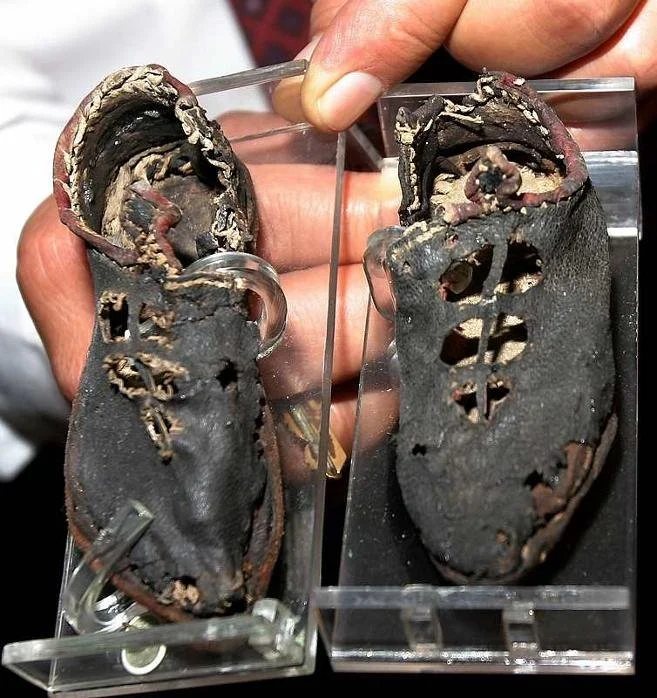The ancient city of Palmyra, located in modern-day Syria, has stood as a symbol of cultural and historical significance for centuries. Known in antiquity as Tadmor, this remarkable city emerged around the third millennium B.C. near a natural oasis, a location that contributed to its evolution into a thriving trading hub along the legendary Silk Road. As a center connecting the East and the West, Palmyra became a melting pot of civilizations, leaving behind a legacy that continues to captivate historians and archaeologists. Among its many fascinating discoveries, one stands out for its personal and poignant insight into the daily life of its inhabitants: a pair of 2,000-year-old children’s shoes. This rare find not only deepens our understanding of the city’s vibrant past but also offers a humanizing glimpse into the lives of those who once walked its streets.

The Discovery of Ancient Children’s Shoes
Amidst Palmyra’s majestic ruins—characterized by grand colonnades, towering temples, and intricate funerary monuments—archaeologists uncovered a small yet extraordinary artifact: a pair of children’s shoes. These tiny leather shoes, preserved for millennia by the region’s arid conditions, stand in stark contrast to the imposing architectural wonders that dominate the site. Their discovery serves as a deeply personal reminder of the everyday lives lived within this grand city. Unlike the monumental remains that speak of Palmyra’s economic and political stature, these shoes provide a tangible connection to the city’s youngest residents, sparking curiosity about their lives, families, and experiences.
Palmyra’s Role as a Cultural Crossroads
Palmyra’s strategic location between the Roman Empire to the west and the Persian Empire to the east established it as a vital node along the Silk Road. This position not only facilitated the exchange of goods but also fostered the mingling of ideas, traditions, and artistic styles from diverse cultures. The city’s architecture reflects this blend, incorporating Roman, Persian, and Greco-Roman influences into its grand temples and public spaces. However, the discovery of personal items, such as children’s shoes, textiles, and jewelry, enriches this narrative, revealing the lives of ordinary individuals who contributed to Palmyra’s vibrant culture. These artifacts underscore the city’s role not just as a trading hub, but as a place where human stories unfolded amid the bustling exchange of commerce and culture.
Insights into Daily Life
The children’s shoes unearthed in Palmyra offer a rare window into the intimate aspects of life in the ancient city. The craftsmanship of the shoes suggests that they were created with skill and care, likely reflecting the city’s extensive trade networks and access to high-quality materials. The shoes’ design and preservation reveal details about the clothing and footwear commonly used during the Roman era. Moreover, their existence hints at the rhythms of family life in Palmyra, a bustling metropolis where children played, families thrived, and communities came together.
This discovery shifts the focus of archaeological interest from Palmyra’s monumental structures to the personal lives of its inhabitants. It highlights the connections between Palmyra’s residents and the broader world, as materials and techniques used to create such artifacts were often imported or inspired by distant cultures. Through these small but meaningful objects, we gain a deeper appreciation for the people who once called this desert oasis their home.
The Significance of Personal Artifacts
Artifacts like the 2,000-year-old children’s shoes remind us that even in cities known for their grandeur and historical importance, everyday life continued in much the same way as it does today. Families cared for their children, artisans honed their crafts, and communities celebrated their shared traditions. Such personal items humanize the ancient past, offering a narrative that complements the stories told by monumental architecture and inscriptions.
These shoes, in particular, challenge us to think beyond Palmyra’s reputation as a center of wealth and power. They serve as a reminder that the city’s legacy is not only defined by its role in history but also by the lives of its people. Each artifact discovered—whether it be a piece of jewelry, a fragment of textile, or a child’s shoe—adds another layer to the story of Palmyra, painting a fuller picture of its society and culture.
Palmyra’s Enduring Legacy
Despite the damage inflicted upon Palmyra in recent years, its legacy endures through the artifacts and knowledge preserved by archaeologists. The children’s shoes, along with countless other discoveries, continue to shed light on the city’s dynamic history. Palmyra was more than just a point on the map of ancient trade routes; it was a place where diverse communities converged, exchanging ideas, goods, and traditions that left an indelible mark on human history.
The preservation of these artifacts serves as a testament to the resilience of cultural heritage, even in the face of destruction. As new discoveries emerge from ongoing excavations, the narrative of Palmyra’s past becomes richer and more nuanced. Each artifact tells a story, connecting us to the lives of people who lived thousands of years ago and reminding us of the shared humanity that transcends time and space.
The discovery of the 2,000-year-old children’s shoes in Palmyra is a profound reminder of the personal histories embedded within the ruins of great civilizations. While grand monuments and inscriptions may chronicle the achievements of rulers and empires, small, everyday items like these shoes reveal the lives of ordinary people—their joys, struggles, and daily routines. As archaeologists continue to uncover new treasures, the story of Palmyra and its inhabitants will remain a source of fascination and inspiration, preserving the memory of a city that once bridged the gap between East and West.





